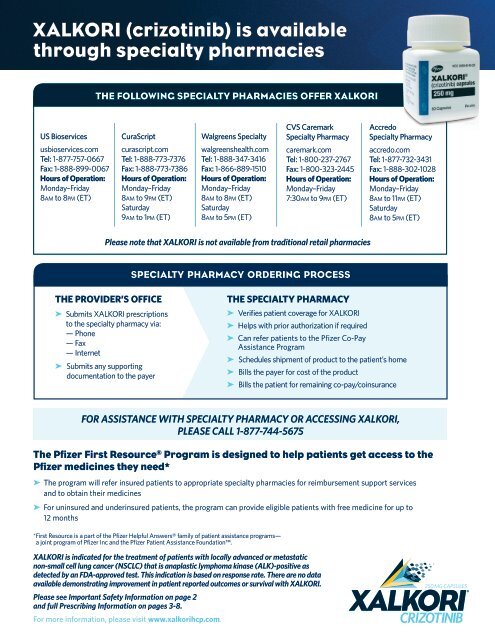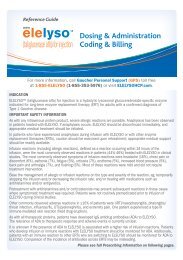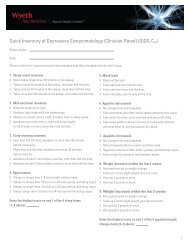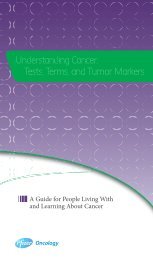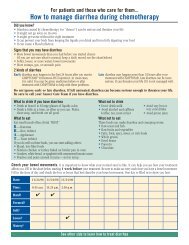XALKORI (crizotinib) is available through specialty ... - PfizerPro
XALKORI (crizotinib) is available through specialty ... - PfizerPro
XALKORI (crizotinib) is available through specialty ... - PfizerPro
You also want an ePaper? Increase the reach of your titles
YUMPU automatically turns print PDFs into web optimized ePapers that Google loves.
<strong>XALKORI</strong> (<strong>crizotinib</strong>) <strong>is</strong> <strong>available</strong><br />
<strong>through</strong> <strong>specialty</strong> pharmacies<br />
THE FOLLOWING SPECIALTY PHARMACIES OFFER <strong>XALKORI</strong><br />
US Bioservices<br />
usbioservices.com<br />
Tel: 1-877-757-0667<br />
Fax: 1-888-899-0067<br />
Hours of Operation:<br />
Monday–Friday<br />
8am to 8pm (ET)<br />
CuraScript<br />
curascript.com<br />
Tel: 1-888-773-7376<br />
Fax: 1-888-773-7386<br />
Hours of Operation:<br />
Monday–Friday<br />
8am to 9pm (ET)<br />
Saturday<br />
9am to 1pm (ET)<br />
Walgreens Specialty<br />
walgreenshealth.com<br />
Tel: 1-888-347-3416<br />
Fax: 1-866-889-1510<br />
Hours of Operation:<br />
Monday–Friday<br />
8am to 8pm (ET)<br />
Saturday<br />
8am to 5pm (ET)<br />
CVS Caremark<br />
Specialty Pharmacy<br />
caremark.com<br />
Tel: 1-800-237-2767<br />
Fax: 1-800-323-2445<br />
Hours of Operation:<br />
Monday–Friday<br />
7:30am to 9pm (ET)<br />
Accredo<br />
Specialty Pharmacy<br />
accredo.com<br />
Tel: 1-877-732-3431<br />
Fax: 1-888-302-1028<br />
Hours of Operation:<br />
Monday–Friday<br />
8am to 11pm (ET)<br />
Saturday<br />
8am to 5pm (ET)<br />
Please note that <strong>XALKORI</strong> <strong>is</strong> not <strong>available</strong> from traditional retail pharmacies<br />
SPECIALTY PHARMACY ORDERING PROCESS<br />
THE PROVIDER’S OFFICE<br />
➤ Submits <strong>XALKORI</strong> prescriptions<br />
to the <strong>specialty</strong> pharmacy via:<br />
— Phone<br />
— Fax<br />
— Internet<br />
➤ Submits any supporting<br />
documentation to the payer<br />
THE SPECIALTY PHARMACY<br />
➤ Verifies patient coverage for <strong>XALKORI</strong><br />
➤ Helps with prior authorization if required<br />
➤ Can refer patients to the Pfizer Co-Pay<br />
Ass<strong>is</strong>tance Program<br />
➤ Schedules shipment of product to the patient’s home<br />
➤ Bills the payer for cost of the product<br />
➤ Bills the patient for remaining co-pay/coinsurance<br />
FOR ASSISTANCE WITH SPECIALTY PHARMACY OR ACCESSING <strong>XALKORI</strong>,<br />
PLEASE CALL 1-877-744-5675<br />
The Pfizer First Resource ® Program <strong>is</strong> designed to help patients get access to the<br />
Pfizer medicines they need*<br />
➤ The program will refer insured patients to appropriate <strong>specialty</strong> pharmacies for reimbursement support services<br />
and to obtain their medicines<br />
➤ For uninsured and underinsured patients, the program can provide eligible patients with free medicine for up to<br />
12 months<br />
*First Resource <strong>is</strong> a part of the Pfizer Helpful Answers® family of patient ass<strong>is</strong>tance programs—<br />
a joint program of Pfizer Inc and the Pfizer Patient Ass<strong>is</strong>tance Foundation.<br />
<strong>XALKORI</strong> <strong>is</strong> indicated for the treatment of patients with locally advanced or metastatic<br />
non-small cell lung cancer (NSCLC) that <strong>is</strong> anaplastic lymphoma kinase (ALK)-positive as<br />
detected by an FDA-approved test. Th<strong>is</strong> indication <strong>is</strong> based on response rate. There are no data<br />
<strong>available</strong> demonstrating improvement in patient reported outcomes or survival with <strong>XALKORI</strong>.<br />
Please see Important Safety Information on page 2<br />
and full Prescribing Information on pages 3-8.<br />
For more information, please v<strong>is</strong>it www.xalkorihcp.com.
<strong>XALKORI</strong> <strong>is</strong> indicated for the treatment of patients with locally advanced or metastatic non-small cell lung cancer (NSCLC)<br />
that <strong>is</strong> anaplastic lymphoma kinase (ALK)-positive as detected by an FDA-approved test.<br />
Th<strong>is</strong> indication <strong>is</strong> based on response rate. There are no data <strong>available</strong> demonstrating improvement in patient reported outcomes<br />
or survival with <strong>XALKORI</strong>.<br />
IMPORTANT SAFETY INFORMATION<br />
Hepatotoxicity: Drug-induced hepatotoxicity with fatal outcome has occurred. Transaminase elevations generally occurred within the first<br />
2 months of treatment. Monitor with liver function tests including ALT and total bilirubin once a month and as clinically indicated, with more<br />
frequent repeat testing for increased liver transaminases, alkaline phosphatase, or total bilirubin in patients who develop transaminase<br />
elevations. Temporarily suspend, dose reduce, or permanently d<strong>is</strong>continue <strong>XALKORI</strong> as indicated.<br />
Pneumonit<strong>is</strong>: <strong>XALKORI</strong> has been associated with severe, life-threatening, or fatal treatment-related pneumonit<strong>is</strong> in clinical trials with a<br />
frequency of 4 in 255 (1.6%) patients. All of these cases occurred within 2 months after the initiation of treatment. Monitor patients for<br />
pulmonary symptoms indicative of pneumonit<strong>is</strong>. Exclude other causes and permanently d<strong>is</strong>continue <strong>XALKORI</strong> in patients with treatmentrelated<br />
pneumonit<strong>is</strong>.<br />
QT Interval Prolongation: QTc prolongation has been observed. Avoid use of <strong>XALKORI</strong> in patients with congenital long QT syndrome.<br />
Consider periodic monitoring with electrocardiograms (ECGs) and electrolytes in patients with congestive heart failure, bradyarrhythmias,<br />
electrolyte abnormalities, or who are taking medications that are known to prolong the QT interval. Permanently d<strong>is</strong>continue <strong>XALKORI</strong> for<br />
grade 4 QTc prolongation. <strong>XALKORI</strong> should be withheld for grade 3 QTc prolongation until recovery to ≤ grade 1. Permanently d<strong>is</strong>continue<br />
<strong>XALKORI</strong> if grade 3 QTc prolongation recurs.<br />
ALK Testing: Detection of ALK-positive NSCLC using an FDA-approved test, indicated for th<strong>is</strong> use, <strong>is</strong> necessary for selection of patients for<br />
treatment with <strong>XALKORI</strong>.<br />
Pregnancy: <strong>XALKORI</strong> can cause fetal harm when admin<strong>is</strong>tered to a pregnant woman based on its mechan<strong>is</strong>m of action. Women of childbearing<br />
potential should be adv<strong>is</strong>ed to avoid becoming pregnant while receiving <strong>XALKORI</strong>. If the patient or their partner becomes pregnant while<br />
taking th<strong>is</strong> drug, appr<strong>is</strong>e the patient of the potential hazard to the fetus.<br />
Adverse Reactions: Among the 397 patients for whom information on deaths and serious adverse reactions <strong>is</strong> <strong>available</strong>, deaths within 28<br />
days of the last dose of study drug occurred in 45 patients. Ten (2.5%) patients died within 28 days of their first dose of study drug. Causes<br />
of death included d<strong>is</strong>ease progression (32 patients), respiratory events (9), and other (4).<br />
Safety of <strong>XALKORI</strong> was evaluated in 255 patients with locally advanced or metastatic ALK-positive NSCLC in 2 single-arm clinical trials<br />
(Studies A and B). The most common adverse reactions (≥25%) across both studies were v<strong>is</strong>ion d<strong>is</strong>order, nausea, diarrhea, vomiting, edema,<br />
and constipation. Grade 3-4 adverse reactions in ≥4% of patients in both studies included ALT increased and neutropenia.<br />
• V<strong>is</strong>ion d<strong>is</strong>orders including v<strong>is</strong>ual impairment, photopsia, v<strong>is</strong>ion blurred, vitreous floaters, photophobia, and diplopia were reported<br />
in 159 (62%) patients in clinical trials. Consider ophthalmological evaluation, particularly if patients experience photopsia or<br />
experience new or increased vitreous floaters. Severe or worsening vitreous floaters and/or photopsia could also be signs of a<br />
retinal hole or pending retinal detachment. Adv<strong>is</strong>e patients to exerc<strong>is</strong>e caution when driving or operating machinery due to the r<strong>is</strong>k<br />
of developing a v<strong>is</strong>ion d<strong>is</strong>order.<br />
• Neuropathy attributed to study drug was reported in 34 (13%) patients. Grade 2 motor neuropathy and grade 3 peripheral neuropathy<br />
were reported in 1 patient each.<br />
• Bradycardia was reported in 12 (5%) patients treated with <strong>XALKORI</strong>. All of these cases were grade 1 or 2 in severity.<br />
• Complex renal cysts were reported in 2 (1%) patients treated with <strong>XALKORI</strong>. There were no reports of abnormal urinalyses or<br />
renal impairment in these cases.<br />
Grade 3 or 4 laboratory abnormalities of neutropenia, thrombocytopenia, and lymphopenia were observed in 5.2%, 0.4%, and 11.4% of<br />
patients, respectively.<br />
Drug Interactions: Exerc<strong>is</strong>e caution with concomitant use of moderate CYP3A inhibitors. Avoid grapefruit or grapefruit juice which may<br />
increase plasma concentrations of <strong>crizotinib</strong>. Avoid concomitant use of strong CYP3A inducers and inhibitors. Dose reduction may be<br />
needed for coadmin<strong>is</strong>tered drugs that are predominantly metabolized by CYP3A.<br />
Nursing Mothers: Given the potential for serious adverse reactions in nursing infants, consider whether to d<strong>is</strong>continue nursing or<br />
d<strong>is</strong>continue <strong>XALKORI</strong>.<br />
Hepatic Impairment: <strong>XALKORI</strong> has not been studied in patients with hepatic impairment. As <strong>crizotinib</strong> <strong>is</strong> extensively metabolized in the liver,<br />
hepatic impairment <strong>is</strong> likely to increase plasma <strong>crizotinib</strong> concentrations. Use caution in patients with hepatic impairment.<br />
Renal Impairment: No starting dose adjustment <strong>is</strong> needed for patients with mild and moderate renal impairment. No data are <strong>available</strong> for<br />
patients with end-stage renal d<strong>is</strong>ease. Use caution in patients with severe renal impairment or patients with end-stage renal d<strong>is</strong>ease.<br />
<strong>XALKORI</strong> <strong>is</strong> a reg<strong>is</strong>tered trademark of Pfizer Inc.<br />
Please see full Prescribing Information on pages 3-8.<br />
For more information, please v<strong>is</strong>it www.xalkorihcp.com.<br />
CRI00135A1-3/CRI456306 © 2012 Pfizer Inc. All rights reserved. April 2012
HIGHLIGHTS OF PRESCRIBING INFORMATION<br />
These highlights do not include all the information needed to use <strong>XALKORI</strong> ® safely<br />
and effectively. See full prescribing information for <strong>XALKORI</strong>.<br />
<strong>XALKORI</strong> ® (<strong>crizotinib</strong>) Capsules, oral<br />
Initial U.S. Approval: August 2011<br />
-----------------------------------RECENT MAJOR CHANGES--------------------------------------<br />
Warnings and Precautions, Hepatotoxicity (5.1) 02/2012<br />
-----------------------------------INDICATIONS AND USAGE--------------------------------------<br />
<strong>XALKORI</strong> <strong>is</strong> a kinase inhibitor indicated for the treatment of patients with locally advanced<br />
or metastatic non-small cell lung cancer (NSCLC) that <strong>is</strong> anaplastic lymphoma kinase<br />
(ALK)-positive as detected by an FDA-approved test. (1) Th<strong>is</strong> indication <strong>is</strong> based on<br />
response rate. There are no data <strong>available</strong> demonstrating improvement in patient reported<br />
outcomes or survival with <strong>XALKORI</strong>.<br />
------------------------------DOSAGE AND ADMINISTRATION------------------------------------<br />
• 250 mg taken orally twice daily with or without food. (2.1)<br />
• Dosing interruption and/or dose reduction to 200 mg taken orally twice daily may be<br />
required based on individual safety and tolerability, then to 250 mg taken orally once<br />
daily if further reduction <strong>is</strong> necessary. (2.2)<br />
-----------------------------DOSAGE FORMS AND STRENGTHS---------------------------------<br />
• Capsules: 250 mg and 200 mg (3)<br />
------------------------------------------CONTRAINDICATIONS------------------------------------<br />
• None (4)<br />
-------------------------------WARNINGS AND PRECAUTIONS-----------------------------------<br />
• Hepatotoxicity: Drug-induced hepatotoxicity with fatal outcome has occurred. Monitor<br />
monthly and as clinically indicated with more frequent testing in patients with Grade 2-<br />
4 elevations. Temporarily suspend, dose reduce, or permanently d<strong>is</strong>continue <strong>XALKORI</strong><br />
as indicated. (5.1)<br />
FULL PRESCRIBING INFORMATION: CONTENTS*<br />
1 INDICATIONS AND USAGE<br />
2 DOSAGE AND ADMINISTRATION<br />
2.1 Recommended Dosing<br />
2.2 Dose Modification<br />
3 DOSAGE FORMS AND STRENGTHS<br />
4 CONTRAINDICATIONS<br />
5 WARNINGS AND PRECAUTIONS<br />
5.1 Hepatotoxicity<br />
5.2 Pneumonit<strong>is</strong><br />
5.3 QT Interval Prolongation<br />
5.4 ALK Testing<br />
5.5 Pregnancy<br />
6 ADVERSE REACTIONS<br />
7 DRUG INTERACTIONS<br />
7.1 Drugs That May Increase Crizotinib Plasma Concentrations<br />
7.2 Drugs That May Decrease Crizotinib Plasma Concentrations<br />
7.3 Drugs Whose Plasma Concentrations May Be Altered By Crizotinib<br />
• Pneumonit<strong>is</strong>: Severe, including fatal, treatment-related pneumonit<strong>is</strong> has been observed.<br />
Monitor patients for pulmonary symptoms indicative of pneumonit<strong>is</strong>. Permanently<br />
d<strong>is</strong>continue in patients diagnosed with treatment-related pneumonit<strong>is</strong>. (5.2)<br />
• QT Interval Prolongation: In patients who have a h<strong>is</strong>tory of or pred<strong>is</strong>position for QTc<br />
prolongation, or who are taking medications that are known to prolong the QT interval,<br />
consider periodic monitoring with electrocardiograms and electrolytes. (5.3)<br />
• ALK Testing: Detection of ALK-positive NSCLC using an FDA-approved test, indicated<br />
for th<strong>is</strong> use, <strong>is</strong> necessary for selection of patients for treatment with <strong>XALKORI</strong>. (5.4)<br />
• Pregnancy: <strong>XALKORI</strong> can cause fetal harm when admin<strong>is</strong>tered to a pregnant woman.<br />
(5.5, 8.1)<br />
-------------------------------------ADVERSE REACTIONS-----------------------------------------<br />
The most common adverse reactions (≥25%) are v<strong>is</strong>ion d<strong>is</strong>order, nausea, diarrhea,<br />
vomiting, edema, and constipation. (6)<br />
To report SUSPECTED ADVERSE REACTIONS, contact Pfizer Inc. at 1-800-438-1985 or<br />
FDA at 1-800-FDA-1088 or www.fda.gov/medwatch.<br />
------------------------------------------DRUG INTERACTIONS------------------------------------<br />
• CYP3A Inhibitors: Avoid concurrent use of <strong>XALKORI</strong> with strong CYP3A inhibitors. (7.1)<br />
• CYP3A Inducers: Avoid concurrent use of <strong>XALKORI</strong> with strong CYP3A inducers. (7.2)<br />
• CYP3A Substrates: Dose reduction may be needed for coadmin<strong>is</strong>tered drugs that are<br />
predominantly metabolized by CYP3A. Avoid concurrent use of <strong>XALKORI</strong> with CYP3A<br />
substrates with narrow therapeutic indices. (7.3)<br />
See 17 for PATIENT COUNSELING INFORMATION and FDA-approved patient labeling.<br />
Rev<strong>is</strong>ed: 2/2013<br />
8 USE IN SPECIFIC POPULATIONS<br />
8.1 Pregnancy<br />
8.3 Nursing Mothers<br />
8.4 Pediatric Use<br />
8.5 Geriatric Use<br />
8.6 Hepatic Impairment<br />
8.7 Renal Impairment<br />
10 OVERDOSAGE<br />
11 DESCRIPTION<br />
12 CLINICAL PHARMACOLOGY<br />
12.1 Mechan<strong>is</strong>m of Action<br />
12.3 Pharmacokinetics<br />
12.4 Cardiac Electrophysiology<br />
13 NONCLINICAL TOXICOLOGY<br />
13.1 Carcinogenes<strong>is</strong>, Mutagenes<strong>is</strong>, Impairment of Fertility<br />
14 CLINICAL STUDIES<br />
16 HOW SUPPLIED/STORAGE AND HANDLING<br />
17 PATIENT COUNSELING INFORMATION<br />
* Sections or subsections omitted from the full prescribing information are not l<strong>is</strong>ted.<br />
FULL PRESCRIBING INFORMATION<br />
1. INDICATIONS AND USAGE<br />
<strong>XALKORI</strong> <strong>is</strong> indicated for the treatment of patients with locally advanced or metastatic<br />
non-small cell lung cancer (NSCLC) that <strong>is</strong> anaplastic lymphoma kinase (ALK)-positive as<br />
detected by an FDA-approved test.<br />
Th<strong>is</strong> indication <strong>is</strong> based on response rate. There are no data <strong>available</strong> demonstrating<br />
improvement in patient reported outcomes or survival with <strong>XALKORI</strong>.<br />
2. DOSAGE AND ADMINISTRATION<br />
2.1 Recommended Dosing<br />
The recommended dose and schedule of <strong>XALKORI</strong> <strong>is</strong> 250 mg taken orally twice daily.<br />
Continue treatment as long as the patient <strong>is</strong> deriving clinical benefit from therapy. <strong>XALKORI</strong><br />
may be taken with or without food. Swallow capsules whole. If a dose of <strong>XALKORI</strong> <strong>is</strong><br />
m<strong>is</strong>sed, make up that dose unless the next dose <strong>is</strong> due within 6 hours.<br />
2.2 Dose Modification<br />
Dosing interruption and/or dose reduction may be required based on individual safety and<br />
tolerability. If dose reduction <strong>is</strong> necessary, then reduce the dose of <strong>XALKORI</strong> to 200 mg<br />
taken orally twice daily. If further dose reduction <strong>is</strong> necessary, then reduce the dosage<br />
to 250 mg taken orally once daily. Dose reduction guidelines for hematologic and nonhematologic<br />
toxicities are provided in Tables 1 and 2.<br />
Table 1: <strong>XALKORI</strong> Dose Modification – Hematologic Toxicities a<br />
CTCAE b Grade <strong>XALKORI</strong> Dosing<br />
Grade 3 Withhold until recovery to Grade ≤2, then resume at the same dose schedule<br />
Grade 4 Withhold until recovery to Grade ≤2, then resume at 200 mg twice daily c<br />
a<br />
Except lymphopenia (unless associated with clinical events, e.g., opportun<strong>is</strong>tic infections).<br />
b<br />
NCI Common Terminology Criteria for Adverse Events.<br />
c<br />
In case of recurrence, withhold until recovery to Grade ≤2, then resume at 250 mg once daily.<br />
Permanently d<strong>is</strong>continue in case of further Grade 4 recurrence.<br />
Table 2: <strong>XALKORI</strong> Dose Modification – Non-Hematologic Toxicities<br />
CTCAE Grade<br />
<strong>XALKORI</strong> Dosing<br />
Grade 3 or 4 alanine aminotransferase (ALT) Withhold until recovery to Grade ≤1 or<br />
or aspartate aminotransferase (AST)<br />
baseline, then resume at 200 mg<br />
elevation with Grade ≤1 total bilirubin<br />
twice daily a<br />
Grade 2, 3 or 4 ALT or AST elevation with<br />
Permanently d<strong>is</strong>continue<br />
concurrent Grade 2, 3 or 4 total bilirubin elevation<br />
(in the absence of cholestas<strong>is</strong> or hemolys<strong>is</strong>)<br />
Any Grade pneumonit<strong>is</strong> b<br />
Permanently d<strong>is</strong>continue<br />
Grade 3 QTc prolongation Withhold until recovery to Grade ≤1,<br />
then resume at 200 mg twice daily a<br />
Grade 4 QTc prolongation<br />
Permanently d<strong>is</strong>continue<br />
a<br />
In case of recurrence, withhold until recovery to Grade ≤1, then resume at 250 mg once daily.<br />
Permanently d<strong>is</strong>continue in case of further Grade 3 or 4 recurrence.<br />
b<br />
Not attributable to NSCLC progression, other pulmonary d<strong>is</strong>ease, infection, or radiation effect.<br />
Monitor complete blood counts including differential white blood cell counts monthly<br />
and as clinically indicated, with more frequent repeat testing if Grade 3 or 4 abnormalities<br />
are observed, or if fever or infection occurs. Monitor liver function tests monthly and as<br />
clinically indicated, with more frequent repeat testing if Grade 2, 3 or 4 abnormalities are<br />
observed.<br />
3. DOSAGE FORMS AND STRENGTHS<br />
250 mg capsules<br />
Hard gelatin capsule, size 0, pink opaque cap and body, with “Pfizer” on the cap and “CRZ<br />
250” on the body.<br />
200 mg capsules<br />
Hard gelatin capsule, size 1, white opaque body and pink opaque cap, with “Pfizer” on the<br />
cap and “CRZ 200” on the body.
4. CONTRAINDICATIONS<br />
None<br />
5. WARNINGS AND PRECAUTIONS<br />
5.1 Hepatotoxicity<br />
Drug-induced hepatotoxicity with fatal outcome has occurred. These cases have occurred<br />
during <strong>XALKORI</strong> treatment in less than 1% of patients in clinical trials. Concurrent<br />
elevations in ALT greater than 3 times the upper limit of normal and total bilirubin greater<br />
than 2 times the upper limit of normal, with normal alkaline phosphatase, occurred in less<br />
than 1% of patients in clinical trials. Elevation in ALT greater than 5 times the upper limit<br />
of normal occurred in 7% of patients in Study A and in 4% of patients in Study B. These<br />
laboratory findings were generally asymptomatic and reversible upon dosing interruption.<br />
Patients usually resumed treatment at a lower dose without recurrence; however,<br />
3 patients from Study A (2%) and 1 patient from Study B (less than 1%) required<br />
permanent d<strong>is</strong>continuation from treatment. Transaminase elevations generally occurred<br />
within the first 2 months of treatment. Monitor with liver function tests including ALT and<br />
total bilirubin once a month and as clinically indicated, with more frequent repeat testing<br />
for increased liver transaminases, alkaline phosphatase, or total bilirubin in patients who<br />
develop transaminase elevations [see Dosage and Admin<strong>is</strong>tration (2.2) and Adverse<br />
Reactions (6)].<br />
5.2 Pneumonit<strong>is</strong><br />
<strong>XALKORI</strong> has been associated with severe, life-threatening, or fatal treatment-related<br />
pneumonit<strong>is</strong> in clinical trials with a frequency of 4 in 255 (1.6%) patients across Studies A<br />
and B. All of these cases occurred within 2 months after the initiation of treatment. Monitor<br />
patients for pulmonary symptoms indicative of pneumonit<strong>is</strong>. Exclude other causes of<br />
pneumonit<strong>is</strong>, and permanently d<strong>is</strong>continue <strong>XALKORI</strong> in patients diagnosed with treatmentrelated<br />
pneumonit<strong>is</strong> [see Dosage and Admin<strong>is</strong>tration (2.2)].<br />
5.3 QT Interval Prolongation<br />
QTc prolongation has been observed. Avoid use of <strong>XALKORI</strong> in patients with congenital<br />
long QT syndrome. Consider periodic monitoring with electrocardiograms (ECGs)<br />
and electrolytes in patients with congestive heart failure, bradyarrhythmias, electrolyte<br />
abnormalities, or who are taking medications that are known to prolong the QT interval.<br />
Permanently d<strong>is</strong>continue <strong>XALKORI</strong> in patients who develop Grade 4 QTc prolongation.<br />
Withhold <strong>XALKORI</strong> in patients who develop Grade 3 QTc prolongation until recovery<br />
to less than or equal to Grade 1, then resume <strong>XALKORI</strong> at 200 mg twice daily. In case of<br />
recurrence of Grade 3 QTc prolongation, withhold <strong>XALKORI</strong> until recovery to less than or<br />
equal to Grade 1, then resume <strong>XALKORI</strong> at 250 mg once daily. Permanently d<strong>is</strong>continue<br />
<strong>XALKORI</strong> if Grade 3 QTc prolongation recurs [see Dosage and Admin<strong>is</strong>tration (2.2) and<br />
Clinical Pharmacology (12.4)].<br />
5.4 ALK Testing<br />
Detection of ALK-positive NSCLC using an FDA-approved test, indicated for th<strong>is</strong> use, <strong>is</strong><br />
necessary for selection of patients for treatment with <strong>XALKORI</strong> [see Clinical Studies (14)].<br />
Assessment for ALK-positive NSCLC should be performed by laboratories with demonstrated<br />
proficiency in the specific technology being utilized. Improper assay performance<br />
can lead to unreliable test results.<br />
Refer to an FDA-approved test’s package insert for instructions on the identification of<br />
patients eligible for treatment with <strong>XALKORI</strong>.<br />
5.5 Pregnancy<br />
<strong>XALKORI</strong> can cause fetal harm when admin<strong>is</strong>tered to a pregnant woman based on its<br />
mechan<strong>is</strong>m of action. In nonclinical studies in rats, <strong>crizotinib</strong> was embryotoxic and fetotoxic<br />
at exposures similar to and above those observed in humans at the recommended<br />
clinical dose of 250 mg twice daily. There are no adequate and well-controlled studies in<br />
pregnant women using <strong>XALKORI</strong>. If th<strong>is</strong> drug <strong>is</strong> used during pregnancy, or if the patient<br />
becomes pregnant while taking th<strong>is</strong> drug, appr<strong>is</strong>e the patient of the potential hazard to a<br />
fetus [see Use in Specific Populations (8.1)].<br />
6. ADVERSE REACTIONS<br />
Because clinical trials are conducted under widely varying conditions, adverse reaction<br />
rates observed in the clinical trials of a drug cannot be directly compared to rates in the<br />
clinical trials of another drug and may not reflect the rates observed in practice.<br />
In Studies A and B, patients with locally advanced or metastatic ALK-positive NSCLC<br />
received <strong>crizotinib</strong> 250 mg orally twice daily continuously. Among the 255 patients for<br />
whom data on Grade 1-4 adverse reactions are <strong>available</strong>, median exposure to study drug<br />
was 5.1 months in Study A and 7.8 months in Study B. Dosing interruptions occurred in<br />
36% and 45% of patients in Studies A and B, and lasted greater than 2 weeks in 13% and<br />
19% of patients in Studies A and B, respectively. Dose reductions occurred in 44% and<br />
29% of patients in Studies A and B, respectively. The rates of treatment-related adverse<br />
events resulting in permanent d<strong>is</strong>continuation were 6% in Study A and 3% in Study B.<br />
The most common adverse reactions (≥25%) across both studies were v<strong>is</strong>ion d<strong>is</strong>order,<br />
nausea, diarrhea, vomiting, edema, and constipation. Grade 3-4 adverse reactions in at<br />
least 4% of patients in both studies included ALT increased and neutropenia.<br />
Among the 397 patients for whom information on deaths and serious adverse reactions <strong>is</strong><br />
<strong>available</strong>, deaths within 28 days of the last dose of study drug occurred in 45 patients. Ten<br />
(2.5%) patients died within 28 days of their first dose of study drug. Causes of death<br />
included d<strong>is</strong>ease progression (32 patients), respiratory events (9), and other (4).<br />
Respiratory causes of death included pneumonia (2), hypoxia (2), ARDS (1), dyspnea (1),<br />
pneumonit<strong>is</strong> (1), empyema (1), and pulmonary hemorrhage (1). Other causes of deaths<br />
included septic shock, DIC, cardiovascular event, and death due to unknown cause<br />
(1 each). Serious adverse events in greater than or equal to 2% of patients included<br />
pneumonia, dyspnea, and pulmonary embol<strong>is</strong>m.<br />
Table 3 l<strong>is</strong>ts the common adverse reactions on Studies A and B in patients receiving<br />
<strong>XALKORI</strong>.<br />
Table 3: Adverse Reactions in ≥10% of Patients with Locally Advanced or Metastatic<br />
ALK-Positive NSCLC on Studies A and B 1<br />
Adverse Event Treatment Emergent Treatment Related<br />
N=255 N=255<br />
All Grades Grade 3/4 All Grades Grade 3/4<br />
n (%) n (%) n (%) n (%)<br />
Eye D<strong>is</strong>orders<br />
V<strong>is</strong>ion D<strong>is</strong>order 2 163 (64%) 0 159 (62%) 0<br />
Gastrointestinal D<strong>is</strong>orders<br />
Nausea 145 (57%) 2 (
Laboratory Abnormalities<br />
Grade 3 or 4 neutropenia, thrombocytopenia, and lymphopenia occurred in 5.2%, 0.4%,<br />
and 11.4% of patients, respectively.<br />
7. DRUG INTERACTIONS<br />
7.1 Drugs That May Increase Crizotinib Plasma Concentrations<br />
Coadmin<strong>is</strong>tration of <strong>crizotinib</strong> with strong CYP3A inhibitors increases <strong>crizotinib</strong> plasma<br />
concentrations [see Clinical Pharmacology (12.3)]. Avoid concomitant use of strong<br />
CYP3A inhibitors, including but not limited to atazanavir, clarithromycin, indinavir,<br />
itraconazole, ketoconazole, nefazodone, nelfinavir, ritonavir, saquinavir, telithromycin,<br />
troleandomycin, and voriconazole. Avoid grapefruit or grapefruit juice which may also<br />
increase plasma concentrations of <strong>crizotinib</strong>. Exerc<strong>is</strong>e caution with concomitant use of<br />
moderate CYP3A inhibitors.<br />
7.2 Drugs That May Decrease Crizotinib Plasma Concentrations<br />
Coadmin<strong>is</strong>tration of <strong>crizotinib</strong> with strong CYP3A inducers decreases <strong>crizotinib</strong> plasma<br />
concentrations [see Clinical Pharmacology (12.3)]. Avoid concurrent use of strong CYP3A<br />
inducers, including but not limited to carbamazepine, phenobarbital, phenytoin, rifabutin,<br />
rifampin, and St. John’s Wort.<br />
7.3 Drugs Whose Plasma Concentrations May Be Altered By Crizotinib<br />
Crizotinib inhibits CYP3A both in vitro and in vivo [see Clinical Pharmacology (12.3)].<br />
Dose reduction may be needed for coadmin<strong>is</strong>tered drugs that are predominantly<br />
metabolized by CYP3A. Avoid coadmin<strong>is</strong>tration of <strong>crizotinib</strong> with CYP3A substrates with<br />
narrow therapeutic indices, including but not limited to alfentanil, cyclosporine,<br />
dihydroergotamine, ergotamine, fentanyl, pimozide, quinidine, sirolimus, and tacrolimus.<br />
8. USE IN SPECIFIC POPULATIONS<br />
8.1 Pregnancy<br />
Pregnancy Category D [see Warnings and Precautions (5.5)]<br />
<strong>XALKORI</strong> can cause fetal harm when admin<strong>is</strong>tered to a pregnant woman based on its<br />
mechan<strong>is</strong>m of action. There are no adequate and well-controlled studies of <strong>XALKORI</strong> in<br />
pregnant women. In nonclinical studies in rats, <strong>crizotinib</strong> was embryotoxic and fetotoxic<br />
at exposures similar to and above those observed in humans at the recommended clinical<br />
dose of 250 mg twice daily. Crizotinib was admin<strong>is</strong>tered to pregnant rats and rabbits<br />
during organogenes<strong>is</strong> to study the effects on embryo-fetal development. Postimplantation<br />
loss was increased at doses ≥ 50 mg/kg/day (approximately 1.2 times the AUC at the<br />
recommended human dose) in rats. No teratogenic effects were observed in rats at doses<br />
up to the maternally toxic dose of 200 mg/kg/day (approximately 5 times the AUC at the<br />
recommended human dose) or in rabbits at doses of up to 60 mg/kg/day (approximately<br />
3 times the AUC at the recommended human dose), though fetal body weights were<br />
reduced at these doses.<br />
Adv<strong>is</strong>e women of childbearing potential to avoid becoming pregnant while receiving<br />
<strong>XALKORI</strong>. Women of childbearing potential who are receiving th<strong>is</strong> drug, or partners of<br />
women of childbearing potential receiving th<strong>is</strong> drug, should use adequate contraceptive<br />
methods during therapy and for at least 90 days after completing therapy. If th<strong>is</strong> drug <strong>is</strong><br />
used during pregnancy, or if the patient or their partner becomes pregnant while taking th<strong>is</strong><br />
drug, appr<strong>is</strong>e the patient of the potential hazard to a fetus.<br />
8.3 Nursing Mothers<br />
It <strong>is</strong> not known whether <strong>XALKORI</strong> <strong>is</strong> excreted in human milk. Because many drugs are<br />
excreted in human milk and because of the potential for serious adverse reactions in<br />
nursing infants from <strong>XALKORI</strong>, consider whether to d<strong>is</strong>continue nursing or to d<strong>is</strong>continue<br />
the drug, taking into account the importance of the drug to the mother.<br />
8.4 Pediatric Use<br />
The safety and efficacy of <strong>XALKORI</strong> in pediatric patients has not been establ<strong>is</strong>hed.<br />
Decreased bone formation in growing long bones was observed in immature rats at<br />
150 mg/kg/day following once daily dosing for 28 days (approximately 10 times the AUC<br />
in adult patients at the recommended human dose). Other toxicities of potential concern<br />
to pediatric patients have not been evaluated in juvenile animals.<br />
8.5 Geriatric Use<br />
Clinical studies of <strong>XALKORI</strong> did not include sufficient numbers of patients aged 65 and<br />
older to determine whether they respond differently from younger patients. Of the 136<br />
patients in Study A, 19 (14%) were 65 years or older. Of the 119 patients in Study B, 16<br />
(13%) were 65 years or older.<br />
8.6 Hepatic Impairment<br />
<strong>XALKORI</strong> has not been studied in patients with hepatic impairment. As <strong>crizotinib</strong> <strong>is</strong> extensively<br />
metabolized in the liver, hepatic impairment <strong>is</strong> likely to increase plasma <strong>crizotinib</strong><br />
concentrations. Clinical studies excluded patients with AST or ALT greater than 2.5 x ULN,<br />
or greater than 5 x ULN, if due to liver metastases. Patients with total bilirubin greater than<br />
1.5 x ULN were also excluded. Therefore, use caution in patients with hepatic impairment<br />
[see Clinical Pharmacology (12.3)].<br />
8.7 Renal Impairment<br />
No starting dose adjustment <strong>is</strong> needed for patients with mild (creatinine clearance [CLcr]<br />
60 to 90 mL/min) and moderate renal impairment (CLcr 30 to 60 mL/min), as steady-state<br />
trough concentrations in these two groups were similar to those in patients with normal<br />
renal function (CLcr greater than 90 mL/min) in Study B. The potential need for starting<br />
dose adjustment in patients with severe renal impairment cannot be determined, as<br />
clinical and pharmacokinetic data were <strong>available</strong> for only one patient. In addition, no data<br />
are <strong>available</strong> for patients with end-stage renal d<strong>is</strong>ease. Therefore, use caution in patients<br />
with severe renal impairment (CLcr less than 30 mL/min) or patients with end-stage renal<br />
d<strong>is</strong>ease [see Clinical Pharmacology (12.3)].<br />
10. OVERDOSAGE<br />
There have been no known cases of <strong>XALKORI</strong> overdose. Treatment of overdose with<br />
<strong>XALKORI</strong> should cons<strong>is</strong>t of general supportive measures. There <strong>is</strong> no antidote for<br />
<strong>XALKORI</strong>.<br />
11. DESCRIPTION<br />
<strong>XALKORI</strong> (<strong>crizotinib</strong>) <strong>is</strong> an oral receptor tyrosine kinase inhibitor. The molecular formula<br />
for <strong>crizotinib</strong> <strong>is</strong> C 21<br />
H 22<br />
Cl 2<br />
FN 5<br />
O. The molecular weight <strong>is</strong> 450.34 Daltons. Crizotinib <strong>is</strong><br />
described chemically as (R)-3-[1-(2,6-Dichloro-3-fluorophenyl)ethoxy]-5-[1-(piperidin-4-<br />
yl)-1H-pyrazol-4-yl]pyridin-2-amine.<br />
The chemical structure of <strong>crizotinib</strong> <strong>is</strong> shown below:<br />
Crizotinib <strong>is</strong> a white to pale-yellow powder with a pKa of 9.4 (piperidinium cation) and 5.6<br />
(pyridinium cation). The solubility of <strong>crizotinib</strong> in aqueous media decreases over the range<br />
pH 1.6 to pH 8.2 from greater than 10 mg/mL to less than 0.1 mg/mL. The log of the<br />
d<strong>is</strong>tribution coefficient (octanol/water) at pH 7.4 <strong>is</strong> 1.65.<br />
<strong>XALKORI</strong> capsules are supplied as printed hard-shell capsules containing 250 mg or<br />
200 mg of <strong>crizotinib</strong> together with colloidal silicon dioxide, microcrystalline cellulose,<br />
anhydrous dibasic calcium phosphate, sodium starch glycolate, magnesium stearate, and<br />
hard gelatin capsule shells as inactive ingredients.<br />
The pink opaque capsule shell components contain gelatin, titanium dioxide, and red iron<br />
oxide. The white opaque capsule shell components contain gelatin, and titanium dioxide.<br />
The printing ink contains shellac, propylene glycol, strong ammonia solution, potassium<br />
hydroxide, and black iron oxide.<br />
12. CLINICAL PHARMACOLOGY<br />
12.1 Mechan<strong>is</strong>m of Action<br />
Crizotinib <strong>is</strong> an inhibitor of receptor tyrosine kinases including ALK, Hepatocyte Growth<br />
Factor Receptor (HGFR, c-Met), and Recepteur d’Origine Nanta<strong>is</strong> (RON). Translocations can<br />
affect the ALK gene resulting in the expression of oncogenic fusion proteins. The formation<br />
of ALK fusion proteins results in activation and dysregulation of the gene’s expression<br />
and signaling which can contribute to increased cell proliferation and survival in tumors<br />
expressing these proteins. Crizotinib demonstrated concentration-dependent inhibition of<br />
ALK and c-Met phosphorylation in cell-based assays using tumor cell lines and<br />
demonstrated antitumor activity in mice bearing tumor xenografts that expressed EML4-<br />
or NPM-ALK fusion proteins or c-Met.<br />
12.3 Pharmacokinetics<br />
Absorption<br />
Following oral single-dose admin<strong>is</strong>tration, <strong>crizotinib</strong> was absorbed with median time to<br />
achieve peak concentration of 4 to 6 hours. Following <strong>crizotinib</strong> 250 mg twice daily, steady<br />
state was reached within 15 days and remained stable, with a median accumulation ratio<br />
of 4.8. Steady state systemic exposure (C min<br />
and AUC) appeared to increase in a greater than<br />
dose proportional manner over the dose range of 200-300 mg twice daily.<br />
The mean absolute bioavailability of <strong>crizotinib</strong> was 43% (range: 32% to 66%) following the<br />
admin<strong>is</strong>tration of a single 250 mg oral dose.<br />
A high-fat meal reduced <strong>crizotinib</strong> AUC inf<br />
and C max<br />
by approximately 14%. <strong>XALKORI</strong> can be<br />
admin<strong>is</strong>tered with or without food [see Dosage and Admin<strong>is</strong>tration (2.1)].<br />
D<strong>is</strong>tribution<br />
The geometric mean volume of d<strong>is</strong>tribution (Vss) of <strong>crizotinib</strong> was 1,772 L following<br />
intravenous admin<strong>is</strong>tration of a 50 mg dose, indicating extensive d<strong>is</strong>tribution into t<strong>is</strong>sues<br />
from the plasma.<br />
Binding of <strong>crizotinib</strong> to human plasma proteins in vitro <strong>is</strong> 91% and <strong>is</strong> independent of drug<br />
concentration. In vitro studies suggested that <strong>crizotinib</strong> <strong>is</strong> a substrate for P-glycoprotein<br />
(P-gp). The blood-to-plasma concentration ratio <strong>is</strong> approximately 1.<br />
Metabol<strong>is</strong>m<br />
In vitro studies demonstrated that <strong>crizotinib</strong> <strong>is</strong> predominantly metabolized by CYP3A4/5.<br />
The primary metabolic pathways in humans were oxidation of the piperidine ring to <strong>crizotinib</strong><br />
lactam and O-dealkylation, with subsequent Phase 2 conjugation of O-dealkylated<br />
metabolites.<br />
In vitro studies in human liver microsomes demonstrated that <strong>crizotinib</strong> <strong>is</strong> a timedependent<br />
inhibitor of CYP3A.<br />
Elimination<br />
Following single doses of <strong>crizotinib</strong>, the mean apparent plasma terminal half-life of<br />
<strong>crizotinib</strong> was 42 hours in patients.<br />
Following the admin<strong>is</strong>tration of a single 250 mg radiolabeled <strong>crizotinib</strong> dose to healthy<br />
subjects, 63% and 22% of the admin<strong>is</strong>tered dose was recovered in feces and urine,<br />
respectively. Unchanged <strong>crizotinib</strong> represented approximately 53% and 2.3% of the<br />
admin<strong>is</strong>tered dose in feces and urine, respectively.<br />
The mean apparent clearance (CL/F) of <strong>crizotinib</strong> was lower at steady state (60 L/hr) after<br />
250 mg twice daily than that after a single 250 mg oral dose (100 L/hr), which was likely<br />
due to autoinhibition of CYP3A by <strong>crizotinib</strong> after multiple dosing.
Drug Interactions<br />
Coadmin<strong>is</strong>tration of Crizotinib and CYP3A Substrates<br />
Crizotinib inhibits CYP3A both in vitro and in vivo. Coadmin<strong>is</strong>tration of <strong>crizotinib</strong> (250 mg<br />
twice daily for 28 days) in patients resulted in a geometric mean oral midazolam AUC that<br />
was 3.7-fold that observed when midazolam was admin<strong>is</strong>tered alone, suggesting that<br />
<strong>crizotinib</strong> <strong>is</strong> a moderate inhibitor of CYP3A [see Drug Interactions (7.3)].<br />
Coadmin<strong>is</strong>tration of Crizotinib and CYP3A Inhibitors<br />
Coadmin<strong>is</strong>tration of a single 150 mg oral dose of <strong>crizotinib</strong> in the presence of keto conazole<br />
(200 mg twice daily), a strong CYP3A inhibitor, resulted in increases in <strong>crizotinib</strong> systemic<br />
exposure, with <strong>crizotinib</strong> AUC inf<br />
and C max<br />
values that were approximately 3.2-fold and<br />
1.4-fold, respectively, those seen when <strong>crizotinib</strong> was admin<strong>is</strong>tered alone. However, the<br />
magnitude of effect of CYP3A inhibitors on steady-state <strong>crizotinib</strong> exposure has not been<br />
evaluated [see Drug Interactions (7.1)].<br />
Coadmin<strong>is</strong>tration of Crizotinib and CYP3A Inducers<br />
Coadmin<strong>is</strong>tration of a single 250 mg <strong>crizotinib</strong> dose with rifampin (600 mg QD), a strong<br />
CYP3A inducer, decreased <strong>crizotinib</strong> AUC inf<br />
and C max<br />
by 82% and 69%, respectively, compared<br />
to <strong>crizotinib</strong> alone. However, the effect of CYP3A inducers on steady-state <strong>crizotinib</strong><br />
exposure has not been evaluated [see Drug Interactions (7.2)].<br />
Coadmin<strong>is</strong>tration of Crizotinib and Antacids<br />
The aqueous solubility of <strong>crizotinib</strong> <strong>is</strong> pH dependent, with higher pH resulting in lower<br />
solubility. Drugs that elevate the gastric pH (such as proton pump inhibitors, H 2<br />
blockers,<br />
or antacids) may decrease the solubility of <strong>crizotinib</strong> and subsequently reduce its bioavailability.<br />
However, no formal studies have been conducted.<br />
Coadmin<strong>is</strong>tration With Other CYP Substrates<br />
In vitro studies indicated that clinical drug-drug interactions as a result of <strong>crizotinib</strong>mediated<br />
inhibition of the metabol<strong>is</strong>m of substrates for CYP1A2, CYP2C8, CYP2C9,<br />
CYP2C19, or CYP2D6 are unlikely to occur.<br />
Crizotinib <strong>is</strong> an inhibitor of CYP2B6 in vitro. Therefore, <strong>crizotinib</strong> may have the potential to<br />
increase plasma concentrations of coadmin<strong>is</strong>tered drugs that are predominantly metabolized<br />
by CYP2B6.<br />
An in vitro study in human hepatocytes indicated that clinical drug-drug interactions as a<br />
result of <strong>crizotinib</strong>-mediated induction of the metabol<strong>is</strong>m of substrates for CYP1A2,<br />
CYP2B6 or CYP3A are unlikely to occur.<br />
Coadmin<strong>is</strong>tration With Substrates of Transporters<br />
Crizotinib <strong>is</strong> an inhibitor of P-glycoprotein (P-gp) in vitro. Therefore, <strong>crizotinib</strong> may have<br />
the potential to increase plasma concentrations of coadmin<strong>is</strong>tered substrates of P-gp.<br />
In vitro, <strong>crizotinib</strong> did not inhibit the human hepatic uptake transport proteins OATP1B1 or<br />
OATP1B3 at therapeutic concentrations. Therefore, clinical drug-drug interactions as a<br />
result of <strong>crizotinib</strong>-mediated inhibition of the hepatic uptake of substrates for these<br />
transporters are unlikely to occur.<br />
Pharmacokinetics in Special Populations<br />
Hepatic Impairment: As <strong>crizotinib</strong> <strong>is</strong> extensively metabolized in the liver, hepatic impairment<br />
<strong>is</strong> likely to increase plasma <strong>crizotinib</strong> concentrations. However, <strong>XALKORI</strong> has not<br />
been studied in patients with hepatic impairment. Clinical studies excluded patients with<br />
ALT or AST greater than 2.5 x ULN or greater than 5 x ULN if due to liver metastases.<br />
Patients with total bilirubin greater than 1.5 x ULN were also excluded [see Use in Specific<br />
Populations (8.6)].<br />
Renal Impairment: No dedicated renal impairment trial for <strong>XALKORI</strong> has been conducted.<br />
In Study B, steady-state trough concentrations in patients with mild (CLcr 60 to 90 mL/min,<br />
N=47) and moderate renal impairment (CLcr 30 to 60 mL/min, N=27) were similar to those<br />
in patients with normal renal function (CLcr greater than 90 mL/min, N=33). Limited data<br />
(N=1) are <strong>available</strong> in patients with severe renal impairment, and no data are <strong>available</strong> in<br />
patients with end-stage renal d<strong>is</strong>ease [see Use in Specific Populations (8.7)].<br />
Ethnicity: After 250 mg twice daily dosing, steady-state <strong>crizotinib</strong> C max<br />
and AUC t<br />
in Asian<br />
patients were 1.57- and 1.50-fold those seen in non-Asian patients, respectively.<br />
12.4 Cardiac Electrophysiology<br />
The QT interval prolongation potential of <strong>crizotinib</strong> was assessed in all patients who<br />
received <strong>XALKORI</strong> 250 mg twice daily. Serial ECGs in triplicate were collected following a<br />
single dose and at steady state to evaluate the effect of <strong>crizotinib</strong> on QT intervals. Four of<br />
308 patients (1.3%) were found to have QTcF (corrected QT by the Fridericia method)<br />
greater than or equal to 500 msec, and 10 of 289 patients (3.5%) had an increase from<br />
baseline QTcF greater than or equal to 60 msec by automated machine-read evaluation<br />
of ECG. A pharmacokinetic/pharmacodynamic analys<strong>is</strong> suggested a concentrationdependent<br />
increase in QTcF [see Warnings and Precautions (5.3)].<br />
13. NONCLINICAL TOXICOLOGY<br />
13.1 Carcinogenes<strong>is</strong>, Mutagenes<strong>is</strong>, Impairment of Fertility<br />
Carcinogenicity studies with <strong>crizotinib</strong> have not been conducted.<br />
Crizotinib was genotoxic in an in vitro micronucleus assay in Chinese Hamster Ovary<br />
cultures, in an in vitro human lymphocyte chromosome aberration assay, and in in vivo rat<br />
bone marrow micronucleus assays. Crizotinib was not mutagenic in vitro in the bacterial<br />
reverse mutation (Ames) assay.<br />
No specific studies with <strong>crizotinib</strong> have been conducted in animals to evaluate the effect<br />
on fertility; however, <strong>crizotinib</strong> <strong>is</strong> considered to have the potential to impair reproductive<br />
function and fertility in humans based on findings in repeat-dose toxicity studies in the<br />
rat. Findings observed in the male reproductive tract included testicular pachytene<br />
spermatocyte degeneration in rats given greater than or equal to 50 mg/kg/day for 28 days<br />
(greater than 3 times the AUC at the recommended human dose). Findings observed in the<br />
female reproductive tract included single-cell necros<strong>is</strong> of ovarian follicles of a rat given<br />
500 mg/kg/day (approximately 10 times the recommended human daily dose on a mg/m 2<br />
bas<strong>is</strong>) for 3 days.<br />
14. CLINICAL STUDIES<br />
The use of single-agent <strong>XALKORI</strong> in the treatment of locally advanced or metastatic ALKpositive<br />
NSCLC was investigated in 2 multi-center, single-arm studies (Studies A and B).<br />
Patients enrolled into these studies had received prior systemic therapy, with the exception<br />
of 15 patients in Study B who had no prior systemic treatment for locally advanced or<br />
metastatic d<strong>is</strong>ease. In Study A, ALK-positive NSCLC was identified using the Vys<strong>is</strong> ALK<br />
Break-Apart FISH Probe Kit. In Study B, ALK-positive NSCLC was identified using a<br />
number of local clinical trial assays. The primary efficacy endpoint in both studies was<br />
Objective Response Rate (ORR) according to Response Evaluation Criteria in Solid<br />
Tumors (RECIST). Response was evaluated by the investigator and by an independent<br />
radiology review panel. Duration of Response (DR) was also evaluated. Patients received<br />
250 mg of <strong>XALKORI</strong> orally twice daily. Demographic and d<strong>is</strong>ease character<strong>is</strong>tics for<br />
Studies A and B are provided in Table 4.<br />
Table 4: Demographic and D<strong>is</strong>ease Character<strong>is</strong>tics in Studies A and B<br />
Character<strong>is</strong>tics Study A Study B<br />
N=136 N=119<br />
Sex, n (%)<br />
Male 64 (47) 59 (50)<br />
Female 72 (53) 60 (50)<br />
Age (years)<br />
Median (range) 52 (29-82) 51 (21-79)<br />
Race, n (%)<br />
White 87 (64) 74 (62)<br />
Black 5 (4) 3 (3)<br />
Asian 43 (32) 34 (29)<br />
Other 1 (1) 8 (7)<br />
ECOG PS at baseline, n (%)<br />
0 37 (27) 41 (35)<br />
1 74 (54) 63 (53)<br />
2 – 3 a 25 (18) 15 (13)<br />
Smoking status, n (%)<br />
Never smoked 92 (68) 86 (72)<br />
Former smoker 39 (29) 32 (27)<br />
Current smoker 5 (4) 1 (1)<br />
D<strong>is</strong>ease stage, n (%)<br />
Locally advanced 9 (7) 5 (4)<br />
Metastatic 127 (93) 114 (96)<br />
H<strong>is</strong>tological classification, n (%)<br />
Adenocarcinoma 130 (96) 116 (98)<br />
Large cell carcinoma 1 (1) 1 (1)<br />
Squamous cell carcinoma 0 1 (1)<br />
Adenosquamous carcinoma 3 (2) 0<br />
Other 2 (2) 1 (1)<br />
Prior systemic therapy for locally<br />
advanced or metastatic d<strong>is</strong>ease —<br />
number of regimens, n (%)<br />
0 0 15 (13)<br />
1 13 (10) 34 (29)<br />
2 37 (27) 20 (17)<br />
3 37 (27) 17 (14)<br />
≥4 49 (36) 33 (28)<br />
a<br />
Includes 1 patient with an ECOG PS of 1 at screening but was 3 at baseline.<br />
One hundred thirty-six patients with locally advanced or metastatic ALK-positive NSCLC<br />
from Study A were analyzed at the time of data cutoff. The median duration of treatment<br />
was 22 weeks. Based on investigator assessments, there was 1 complete and 67 partial<br />
responses for an ORR of 50% (95% CI: 42%, 59%). Seventy-nine percent of objective<br />
tumor responses were achieved during the first 8 weeks of treatment. The median<br />
response duration was 41.9 weeks.<br />
One hundred nineteen patients with locally advanced or metastatic ALK-positive NSCLC<br />
were enrolled into Study B at the time of data cutoff. The median duration of treatment<br />
was 32 weeks. Based on investigator assessments, there were 2 complete and 69 partial<br />
responses for an ORR of 61% (95% CI: 52%, 70%). Fifty-five percent of objective tumor<br />
responses were achieved during the first 8 weeks of treatment. The median response<br />
duration was 48.1 weeks.<br />
Efficacy data from Studies A and B are provided in Table 5.<br />
Table 5: Locally Advanced or Metastatic ALK-Positive NSCLC<br />
Efficacy Results from Studies A and B a<br />
Efficacy Parameter Study A Study B<br />
N=136 N=119<br />
Objective Response Rate (CR+PR) b [% (95% CI)] 50% (42%, 59%) 61% (52%, 70%)<br />
Number of Responders 68 71<br />
Duration of Response c [Median (range) weeks] 41.9 (6.1+, 42.1+) 48.1 (4.1+, 76.6+)<br />
a<br />
Response as assessed by the Investigator.<br />
b<br />
One patient was not evaluable for response in Study A; 3 patients were not evaluable for<br />
response in Study B.<br />
c<br />
Preliminary estimate using Kaplan-Meier method.<br />
+Censored values
16. HOW SUPPLIED/STORAGE AND HANDLING<br />
250 mg capsules<br />
Hard gelatin capsule with pink opaque cap and body, printed with black ink “Pfizer” on the<br />
cap, “CRZ 250” on the body; <strong>available</strong> in:<br />
Bottles of 60 capsules: NDC 0069-8140-20<br />
200 mg capsules<br />
Hard gelatin capsule with pink opaque cap and white opaque body, printed with black ink<br />
“Pfizer” on the cap, “CRZ 200” on the body; <strong>available</strong> in:<br />
Bottles of 60 capsules: NDC 0069-8141-20<br />
Store at room temperature 20° to 25°C (68° to 77°F); excursions permitted between 15°<br />
to 30°C (59° to 86°F) [see USP Controlled Room Temperature].<br />
17. PATIENT COUNSELING INFORMATION<br />
See FDA-approved patient labeling (Patient Information).<br />
• Inform patients that symptoms of weakness, fatigue, anorexia, nausea, vomiting,<br />
abdominal pain (especially RUQ abdominal pain), jaundice, dark urine, generalized<br />
pruritus, and bleeding diathes<strong>is</strong>, especially in combination with fever and rash, should<br />
be reported immediately [see Warnings and Precautions (5.1)].<br />
• Inform patients that nausea, diarrhea, vomiting, and constipation are the most<br />
commonly reported gastrointestinal adverse events occurring in patients who received<br />
<strong>XALKORI</strong>. Supportive care for gastrointestinal adverse events requiring treatment<br />
may include standard anti-emetic and/or anti-diarrheal or laxative medications [see<br />
Adverse Reactions (6)].<br />
• Inform patients that v<strong>is</strong>ual changes such as perceived flashes of light, blurry v<strong>is</strong>ion, light<br />
sensitivity, and floaters are commonly reported adverse events. These events began<br />
most commonly during the first two weeks of treatment. Adv<strong>is</strong>e patients to report flashes<br />
or floaters to their physicians [see Adverse Reactions (6)].<br />
• No studies on the effect of <strong>XALKORI</strong> on the ability to drive and use machines have been<br />
performed. However, adv<strong>is</strong>e patients to exerc<strong>is</strong>e caution when driving or operating<br />
machinery due to the r<strong>is</strong>k of developing a v<strong>is</strong>ion d<strong>is</strong>order, dizziness, or fatigue while<br />
taking <strong>XALKORI</strong>[see Adverse Reactions (6)].<br />
• Adv<strong>is</strong>e patients to inform their health care providers of all concomitant medications,<br />
including prescription medicines, over-the-counter drugs, vitamins, and herbal<br />
products [see Drug Interactions (7)].<br />
• Adv<strong>is</strong>e patients to take <strong>XALKORI</strong> exactly as prescribed, not to change their dose or to<br />
stop taking <strong>XALKORI</strong> unless they are told to do so by their doctor. Take <strong>XALKORI</strong> with<br />
or without food. Swallow <strong>XALKORI</strong> capsules whole.<br />
• Adv<strong>is</strong>e patients to keep <strong>XALKORI</strong> in the original container. Do not crush, d<strong>is</strong>solve, or<br />
open capsules.<br />
• Inform patients to avoid grapefruit or grapefruit juice while taking <strong>XALKORI</strong>.<br />
• If a patient m<strong>is</strong>ses a dose, adv<strong>is</strong>e the patient to take it as soon as remembered unless it<br />
<strong>is</strong> less than 6 hours until the next dose, in which case, adv<strong>is</strong>e the patient not to take the<br />
m<strong>is</strong>sed dose. Adv<strong>is</strong>e patients not to take two doses at the same time to make up for a<br />
m<strong>is</strong>sed dose.<br />
• Inform patients of childbearing potential to use adequate contraceptive methods during<br />
therapy and for at least 90 days after completing therapy. Adv<strong>is</strong>e patients to inform their<br />
doctor if they or their partners are pregnant or think they may be pregnant. Also adv<strong>is</strong>e<br />
patients not to breastfeed while taking <strong>XALKORI</strong> [see Use in Specific Populations (8.1<br />
and 8.3)].<br />
LAB-0440-6.0<br />
D<strong>is</strong>tributed by<br />
Pfizer Labs<br />
Div<strong>is</strong>ion of Pfizer Inc, NY, NY 10017<br />
PATIENT INFORMATION<br />
<strong>XALKORI</strong> ® (zal-KOR-ee) (<strong>crizotinib</strong>) Capsules<br />
Read th<strong>is</strong> patient information leaflet before you start taking <strong>XALKORI</strong><br />
and each time you get a refill. There may be new information. Th<strong>is</strong><br />
information does not take the place of talking to your doctor about your<br />
condition or treatment.<br />
What <strong>is</strong> the most important information for me to know about<br />
<strong>XALKORI</strong><br />
<strong>XALKORI</strong> may cause serious side effects, such as:<br />
Liver problems – <strong>XALKORI</strong> may cause life-threatening and/or fatal liver<br />
injury. Your doctor should do blood tests every month to check your<br />
liver while you are taking <strong>XALKORI</strong>. Tell your doctor right away if you<br />
get any of the following:<br />
• your skin or the whites of your eyes turn yellow<br />
• you feel tired<br />
• your urine turns dark or brown (tea color)<br />
• you have nausea or vomiting<br />
• you have a decreased appetite<br />
• you have pain on the right side of your stomach<br />
• you bleed or bru<strong>is</strong>e more easily than normal<br />
• you have itching<br />
Swelling of the lungs (pneumonit<strong>is</strong>) - <strong>XALKORI</strong> may cause lifethreatening<br />
and/or fatal swelling (inflammation) of the lungs during<br />
treatment. Symptoms may be similar to those symptoms from lung<br />
cancer. Tell your doctor right away if you have any new or worsening<br />
symptoms, including:<br />
• trouble breathing or shortness of breath<br />
• cough with or without mucous<br />
• fever<br />
See “What are possible side effects of <strong>XALKORI</strong>” for more information<br />
about side effects.<br />
What <strong>is</strong> <strong>XALKORI</strong><br />
<strong>XALKORI</strong> <strong>is</strong> a prescription medicine that <strong>is</strong> used to treat people with<br />
non-small cell lung cancer (NSCLC) that <strong>is</strong> advanced or that has spread<br />
to other parts of the body and <strong>is</strong> caused by a defect in a gene called ALK<br />
(anaplastic lymphoma kinase).<br />
It <strong>is</strong> not known if <strong>XALKORI</strong> <strong>is</strong> safe and effective in children.<br />
What should I tell my doctor before taking <strong>XALKORI</strong><br />
Before you take <strong>XALKORI</strong>, tell your doctor if you:<br />
• have heart problems, including a condition called long QT syndrome<br />
• have liver or kidney problems<br />
• have any other medical conditions<br />
• are pregnant, or plan to become pregnant. <strong>XALKORI</strong> may harm your<br />
unborn baby.<br />
o Women who are able to become pregnant and men who<br />
take <strong>XALKORI</strong> should use birth control during treatment<br />
and for 3 months after stopping <strong>XALKORI</strong>.<br />
o Talk to your doctor about the birth control methods that<br />
may be right for you.<br />
o If you or your partner becomes pregnant, tell your doctor<br />
right away.<br />
• are breastfeeding or plan to breastfeed. It <strong>is</strong> not known if <strong>XALKORI</strong><br />
passes into your breast milk. You and your doctor should decide if you<br />
will take <strong>XALKORI</strong> or breastfeed. You should not do both.
Tell your doctor about the medicines you take, including prescription<br />
medicines, non-prescription medicines, vitamins, and herbal supplements.<br />
Especially tell your doctor if you take:<br />
• St. John’s Wort (Hypericum perforatum)<br />
• Medicines for:<br />
• depression (antidepressants)<br />
• fungal infections (antifungals)<br />
• bacterial infections (antibiotics)<br />
• tuberculos<strong>is</strong> (TB)<br />
• HIV-AIDS<br />
• heart conditions<br />
• seizures<br />
Know the medicines you take. Keep a l<strong>is</strong>t of them to show your doctor<br />
or pharmac<strong>is</strong>t when you get a new medicine.<br />
How should I take <strong>XALKORI</strong><br />
• Take <strong>XALKORI</strong> exactly as your doctor tells you.<br />
• Swallow <strong>XALKORI</strong> capsules whole.<br />
• Do not crush, d<strong>is</strong>solve, or open capsules.<br />
• You may take <strong>XALKORI</strong> with or without food.<br />
• Do not change your dose or stop <strong>XALKORI</strong> unless your doctor tells<br />
you.<br />
• If you m<strong>is</strong>s a dose, take it as soon as you remember. If it <strong>is</strong> close<br />
to your next dose (within 6 hours), just take your next dose at your<br />
regular time.<br />
• Do not take more than 1 dose of <strong>XALKORI</strong> at a time.<br />
• Call your doctor right away if you take too much <strong>XALKORI</strong>.<br />
• Your doctor will check your blood and heart while you are taking<br />
<strong>XALKORI</strong>.<br />
What should I avoid while taking <strong>XALKORI</strong><br />
• You should not drink grapefruit juice or eat grapefruit during your<br />
treatment with <strong>XALKORI</strong>. It may make the amount of <strong>XALKORI</strong> in your<br />
blood increase to a harmful level.<br />
• <strong>XALKORI</strong> can cause changes in your v<strong>is</strong>ion, dizziness, and tiredness.<br />
If you have these symptoms, use caution when driving a car, using<br />
machinery, or doing anything that needs you to be alert.<br />
What are the possible side effects of <strong>XALKORI</strong><br />
<strong>XALKORI</strong> may cause serious side effects:<br />
• See “What <strong>is</strong> most important for me to know about <strong>XALKORI</strong>”<br />
• Changes in your heartbeat (called QT interval prolongation), very fast<br />
or abnormal heartbeats. Your doctor may check your heart during<br />
treatment with <strong>XALKORI</strong>. Tell your doctor right away if you have<br />
abnormal heartbeats, feel dizzy, or faint. These may be symptoms<br />
related to QT interval prolongation.<br />
The most common side effects of <strong>XALKORI</strong> include:<br />
• V<strong>is</strong>ion problems<br />
• These problems usually happen within 2 weeks of starting <strong>XALKORI</strong>.<br />
Tell your doctor right away if you have any change in v<strong>is</strong>ion, such as:<br />
• flashes of light<br />
• blurred v<strong>is</strong>ion<br />
• light hurting your eyes<br />
• new or increased floaters<br />
• nausea<br />
• diarrhea<br />
• vomiting<br />
• swelling of your hands and feet<br />
• constipation<br />
Tell your doctor if you have any side effect that bothers you or that does<br />
not go away.<br />
These are not all of the possible side effects of <strong>XALKORI</strong>. For more<br />
information, ask your doctor or pharmac<strong>is</strong>t.<br />
Call your doctor for medical advice about side effects. You may report<br />
side effects to FDA at 1-800-FDA-1088.<br />
How do I store <strong>XALKORI</strong><br />
Store <strong>XALKORI</strong> at room temperature between 68°F to 77°F (20°C to<br />
25°C).<br />
• Keep <strong>XALKORI</strong> in the original container, and keep the container closed<br />
tightly.<br />
• Do not touch or handle crushed or broken <strong>XALKORI</strong> capsules.<br />
<strong>XALKORI</strong> <strong>is</strong> made with a capsule to prevent contact with the active<br />
ingredient.<br />
Keep <strong>XALKORI</strong> and all medicines out of the reach of children.<br />
General information about <strong>XALKORI</strong><br />
Medicines are sometimes prescribed for purposes other than those l<strong>is</strong>ted<br />
in a Patient Information leaflet. Do not use <strong>XALKORI</strong> for a condition for<br />
which it was not prescribed. Do not give it to other people, even if they<br />
have the same symptoms you have. It may harm them.<br />
Th<strong>is</strong> leaflet provides the most important information about <strong>XALKORI</strong>. If<br />
you would like to know more about <strong>XALKORI</strong> talk with your doctor. You<br />
can ask your doctor or pharmac<strong>is</strong>t for more information about <strong>XALKORI</strong>.<br />
For more information, go to www.<strong>XALKORI</strong>.com.<br />
What are the ingredients in <strong>XALKORI</strong><br />
Active ingredient: <strong>crizotinib</strong>.<br />
Inactive ingredients: colloidal silicon dioxide, microcrystalline cellulose,<br />
anhydrous dibasic calcium phosphate, sodium starch glycolate, and<br />
magnesium stearate.<br />
Pink opaque capsule shell contains: gelatin, titanium dioxide, and red<br />
iron oxide.<br />
White opaque capsule shell contains: gelatin and titanium dioxide.<br />
Printing ink contains: shellac, propylene glycol, strong ammonia<br />
solution, potassium hydroxide, and black iron oxide.<br />
Th<strong>is</strong> Patient Information has been approved by the U.S. Food and Drug<br />
Admin<strong>is</strong>tration<br />
LAB-0441-4.0<br />
Rev<strong>is</strong>ed: February 2013<br />
D<strong>is</strong>tributed by<br />
Pfizer Labs<br />
Div<strong>is</strong>ion of Pfizer Inc, NY, NY 10017


